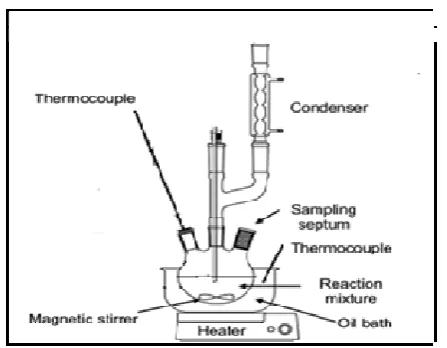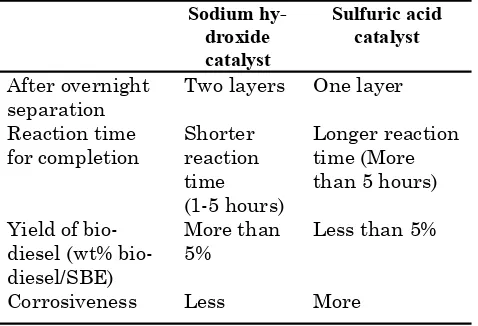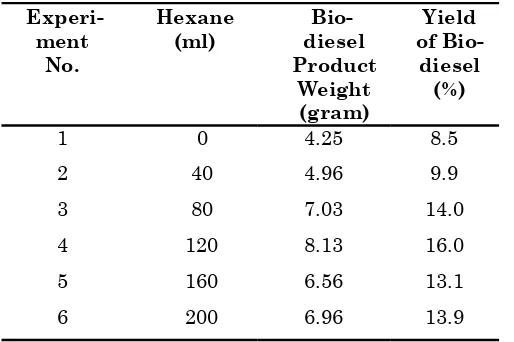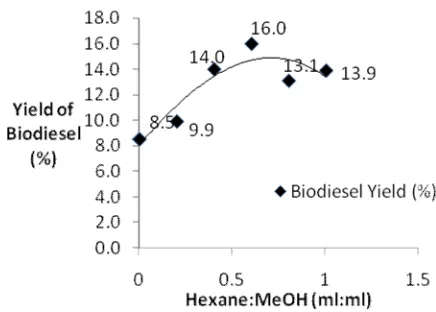1. Introduction
Palm oil industry has emerged since early 20th century and it is widely used in food and cosmetic sectors. Bleaching earth is used to produce better quality of oil by removing colouring substances and trace elements in crude palm oil. Rapid increase in global population has causes an increase in palm oil production; hence, spent bleaching earth (SBE) disposal problems constitute a significant economic waste and an environmental burden. About 1.5-2.0 million tons of SBE are produced worldwide annually, and it is estimated that 30% of oil in the SBE could be recovered [1].
In Situ Biodiesel Production from Residual Oil Recovered
from Spent Bleaching Earth
Ramli Mat
*, Ow Shin Ling, Anwar Johari, Mahadhir Mohamed
Department of Chemical Engineering, Faculty of Chemical Engineering, Universiti Teknologi Malaysia, 81310 UTM Skudai, Johor, MALAYSIA
* Corresponding Author.
E-mail address: [email protected] (Ramli Mat), Tel: +06-07-5535507, Fax: +06-07-5536165
Bulletin of Chemical Reaction Engineering & Catalysis, 6 (1), 2011, 53 - 57
Received: 19th December 2010; Revised: 10th May 2011; Accepted: 18th May 2011
Abstract
Currently, semi-refined and refined vegetable oils are used as a feedstock in biodiesel production. However, due to competition with conventional fossil fuel, economic reasons, shortage supply of food and its social impact on the global scale has somewhat slowed the development of biodiesel industry. Studies have been conducted to recover oil from mill palm oil operation especially from the spent bleaching earth. Hence, the study was to investigate the potential recovery of oil from spent bleaching earth to be used as a feedstock for biodiesel production. The effect of different types of catalysts (sodium hydroxide alkali and sulfuric acid catalysts) on biodiesel yield was studied. In addition, the effect of volume addition of methanol to the weight of spent bleaching earth on the product yield was also studied. Furthermore, the effect of ratio of hexane to methanol was also carried out to determine its product yield. The studies were carried out in an in-situ biodiesel reactor system and the biodiesel product was analyzed using gas chromatography mass spectrometry. Result shows that the use of alkali catalyst produced the highest yield of biodiesel and the most optimum biodiesel yield was obtained when the methanol to spent bleaching earth ratio was 3.2:1 (gram of methanol: gram of SBE) and hexane to methanol ratio of 0.6:1 (volume of hexane: volume of methanol). © 2011 BCREC UNDIP. All rights reserved
Keywords: Spent bleaching earth, in situ trans-esterification, biodiesel, residual oil
Past practice shows that the spent bleaching earth is normally land filled. However, strong resistance from environmentalists and potential economics returns from recycling of this material has generated substantial interest towards the recovery of oil from SBE [2]. The recovered oil is later subjected to further processing for value added product such as biodiesel via trans-esterification process.
Generally, alkaline catalyst is used in trans-esterification of biodiesel for its fast performance. However, alkaline catalyst is sensitive towards water and the SBE is normally heated to 100°C for the removal of moisture content before the reaction commences. If the moisture and excessive free fatty acid content are more than 0.5% in SBE, the formation of unwanted soap would occur and result Available online at BCREC Website: http://bcrec.undip.ac.id
in the deactivation of catalyst [3]. In industry processes, esterification was first carried out to recover oil for the reduction of free fatty acid content prior to trans-esterification process. However, it would be costly and time consuming if the esterification could not reduce the free fatty acid content to desired percentage, which is below 2%. On the other hand, acidic catalyst which is less sensitive to free fatty acid can prevent the formation of soap but needs longer reaction time.
Most commercial biodiesels are produced from edible vegetable oils which are expensive. One way of reducing biodiesel production costs is to use low cost raw material such as oil recovered oil from the SBE which contain about 30% oil. A two-step catalyzed chemical reaction has been developed to recover oil from the SBE [1]. The economic competitiveness of biodiesel can be significantly improved by applying an “in-situ process”. It is estimated that about 600,000 metric tons or more of bleaching earth are utilized worldwide in the refining process based on the worldwide production of more than 60 million tons of oils. The SBE serves as by-product, which contains high percentage of oil.
The SBE generated annually by Malaysian palm oil refineries is estimated to be approximately 120 000 tons. The potential oil that can be recovered is estimated to be approximately 36 000 tons [4]. Thus it is highly potential to recover the oil by using in situ method for biodiesel production. The research is intended to recover the oil from the SBE for the production of biodiesel using in situ process. In addition, the effects of acid and alkaline catalysts on the yield of biodiesel, mass ratio of methanol to SBE and the ratio of hexane to methanol on in situ process are also highlighted
2. Materials and Method
2.1. Determination of Oil Content
10 gram of SBE was weighed and put in a furnace at 100°C for 24 hours. It was later removed and reweighted which signifies the removal of moisture content from the sample. The moisture free sample was then heated to 400°C in the furnace for 24 hours for the oil removal process since the boiling point for oil is estimated at 300°C [5]. The weight difference of SBE at 100°C and 400°C indicates the weight of oil in SBE. The process is repeated three times for accurate results.
2.2. In Situ Biodiesel Production from Oil Recovered from SBE
The experiments were carried out into two stages. The first step was to study the effect of types of catalyst on the yield of biodiesel. In this case, sodium hydroxide alkali and sulfuric acid catalysts were used. Hence, at this stage, the volume of methanol and hexane was fixed at 100 ml for both chemicals throughout the study. The second stage of the study dealt with the effect of ratio between methanol to SBE on the selected catalyst chosen from the first stage. It was continued with the study of the effect of ratio between hexane to methanol for the maximum performance of biodiesel production. The reactor system used in the experiment is shown in Figure 1.
2.2.1. Study on the Effect of Catalyst Types on the Performance of Biodiesel Production
50 gram of moisture free SBE was weighed while catalyst (sodium hydroxide alkali), methanol (100 ml) and hexane (100 ml) were stirred together in the beaker to generate homogeneous mixture. SBE, hexane and mixture of methanol and catalyst were then poured into round bottom flask and heated using oil bath which was preheated at 65°C for 24 hours with stirring speed of 600 rpm. The setup was refluxed with condenser to prevent evaporation of methanol and hexane since boiling point of methanol and hexane is 64.7°C and 68.74° C respectively. Hexane was used in the study to extract the oil from SBE.
The round bottom flask was later removed from oil bath. The product was filtered by using vacuum Bulletin of Chemical Reaction Engineering & Catalysis, 6 (1), 2011, 54
filter. Then, the filtered product was allowed to be separated in separating funnel for overnight. The upper layer of product was collected and washed using distilled water and shaken appropriately to remove the residual methanol. The product was chromatography mass spectrometry. The process was repeated with sulfuric acid as the catalyst. The biodiesel yield was calculated using the following equation.
% yield of biodiesel = x 100% ………...(1) 2.2.2. Study on the Effect of Methanol to SBE Ratio
Methanol plays a vital role in production of biodiesel. In trans-esterification, stoichiometric molar ratio of methanol and oil is 3:1, however, excess methanol is needed to increase the yields of the alkyl esters and to allow its phase separation from the glycerol formed [6]. Six experiments were conducted according to different methanol to SBE ratios at reaction temperature of 65°C, 5 hours of reaction time and 2 wt% of the selected catalyst. The weight and volume of SBE and hexane were fixed at 50 g and 100 ml respectively.
2.2.3. Study on the Effect of Hexane to Methanol Ratio
A non polar solvent hexane was used to extract residual oil form spent bleaching earth. Lee et al. to improve the extraction rate of oil from SBE. The process was conducted using 65°C reaction
3.1. Determination of Oil Content
SBE contains moisture, residual oils and impurities that arise during degumming,
decolourization and deodorization processes. The average oil content in SBE was 38.13%, which is in the range of 20% to 40% by weight as reported by Taylor et al. [8].
3.2. Effect of Types of Catalyst on Biodiesel Production
The effect of alkali and acid catalyst on the production of biodiesel was investigated. Comparisons were made based on its product yield, completed reaction time as well as its separation bottom. On the other hand, the use of acid catalyst has resulted in a single layer only with no visible separation of the products. Product analyses formed by GC-MS revealed that alkali catalyst produced higher purity of biodiesel than acid catalyst. Furthermore, alkali catalyst needed shorter reaction time than acid catalyst for complete trans-esterification reactions which is similar to report published by Schuchardt et al. [6]. Another drawback of acid catalyst usage is the need of larger methanol to oil ratio as described by Demirbas [9]. In addition, the equipment for the biodiesel production may corrode faster and thus increase the maintenance cost. In view of these results, the alkali catalyst was chosen for further studies involving the effect of methanol to SBE ratio and hexane to methanol ratio.
Bulletin of Chemical Reaction Engineering & Catalysis, 6 (1), 2011, 55
Table 1. Comparison Results of Usage of Acid and Alkali Catalysts
3.3. Effect of Methanol to SBE Ratio
The effect of methanol to SBE ratio was investigated. Six experiments were conducted according to different methanol to SBE ratio with a fixed volume of hexane of 100 ml. Table 2 shows the percentage yield of biodiesel yield.
The volume to mass ratio of 200 ml of methanol to 50 gram of SBE resulted in the highest biodiesel yield which is equivalent to 8.09 g of biodiesel. It shows that the highest ratio of methanol to SBE led to the highest yield of biodiesel. It was due to an increase formation of sodium methoxide from the reactions of methanol and sodium hydroxide. Theoretically, the increase of sodium methoxide leads to an increase in the reaction in which more
Figure 2 shows the trend of biodiesel yield using different methanol to SBE ratio. It showed the yield of biodiesel was ascending gradually when the ratio of methanol to SBE used increased. It can be seen that yield of biodiesel increasing uniformly when ratio of methanol to SBE increased from methanol may slow down the trans-esterification reaction. This could be due to the dilution of the catalyst.
3.4. Effect of Hexane to Methanol Ratio
A non polar solvent hexane was used to improve the extraction of residual oil from SBE [7]. Thus the study on the effect of hexane in in-situ biodiesel production was carried out. Table 3 shows the biodiesel yield from using different volume of ratio of hexane to methanol resulted in an increase in the biodiesel yield. Further increasing the ratio of hexane to methanol above 0.8:1 resulted in the decrease of biodiesel yield. The reduction of biodiesel yield was due to side reactions between methanol and hexane with the impurities in SBE, Bulletin of Chemical Reaction Engineering & Catalysis, 6 (1), 2011, 56
Table 2. Biodiesel Yield Using Different Methanol to 50 g SBE Ratio with 100 ml of Hexane
Experi-Figure 2. Biodiesel Yield from 50 g SBE Using Dif-ferent Methanol to SBE Ratio
Table 3. Biodiesel Yield Using Different Ratio of Hexane to 200 ml of Methanol with 50 g of SBE
Experi-and consequently reduces the rate of reaction in trans-esterification process. In addition, the increased in hexane volume led to the dilution of the oil and sodium methoxide concentration, causing reduction of reaction reactivity and subsequently reducing the rate of reaction and biodiesel yield.
3. Conclusion
Two types of catalysts were used in the study and it is demonstrated that alkali catalyst, sodium hydroxide is more suitable for the biodiesel production from dry SBE compared to acid catalyst, sulfuric acid. Results show the highest yield of biodiesel was obtained if sodium hydroxide was used with methanol to SBE ratio of 3.2:1 (gram of methanol: gram of SBE) and hexane to methanol ratio of 0.6:1 (volume of hexane: volume of methanol). Furthermore, using the ratio of hexane to methanol above 0.6:1 (volume of hexane: volume of methanol) had caused a decreased in the biodiesel yield.
Acknowledgments
The authors wish to thank the Ministry of Higher Education for the funding of this project through FRGS project No. 78541.
Bulletin of Chemical Reaction Engineering & Catalysis, 6 (1), 2011, 57
References
[1] Huang, Y. P., Chang, J. I., 2009. Biodiesel Production From Residual Oils Recovered From Spent Bleaching Earth. Renewable Energy 35:269-274.
[2] Boukerroui, A., Ouali, M. S., 2000. Regeneration of A Spent Bleaching Earth And Its Reuse In The Refining Of An Edible Oil. Journal of Chemical Technology and Biotechnology. 75:773-776.
[3] Lam, M. K., Lee, K. T., Mohamed, A. R., 2010.
Homogeneous, Heterogeneous and
Enzy-matic Catalysis For Transesterification Of High Free Fatty Acid Oil (Waste Cooking Oil) To Biodiesel: A Review. Biotechnology Advances 28:500-518.
[4] Kheang L. S., Choo Y. M., Ma A. N., 2007. Residual Oil from Spent Bleaching Earth for Biodiesel and Biolubricant Applications. MPOB Information Series.
[5] Choo, Y. M., Yung, C. L., Cheng, S. F.,Ma A. N., Chuah, C. H., Basiron, Y., 2005. Key Fuel Properties Of Palm Oil Alkyl Esters. Fuel. 84:1717-1720.
[6] chuchardt, U., Serchelia, R., Vargas, R. M., 1998. Transesterification of Vegetable Oils: a Review. J. Braz. Chem. Soc.. 9:199-210.
[7] Lee, C. G., Seng, C. E., Liew, K. Y., 2000. Solvent Efficiency for Oil Extraction from Spent Bleaching Clay. JAOCS. 77:1219-1223.
[8] Taylor, D.R., Jenkins, D.B., 1999. Factors Affecting the Pyrophorisity of Spent Bleaching Clay. JAOCS. 67:678.
[9] Demirbas A., 1998. Fuel Properties And Calculation Of Higher Heating Values Of Vegetable Oils. Fuel. 77:1117–1120.
[10] Miao, X. L., Li, R. X., Yao, H. Y., 2008. Effective Acid-CatalyzedTransesterification for Biodiesel P ro duc tio n. En er gy Co n ve rsio n a nd Management. 50:2680-2684.



